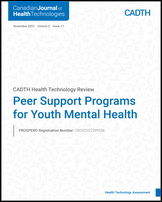|
Depression
Post-intervention: 84 (1 RCT
50
)
Post-booster: 97 (1 RCT
39
)
Follow-up: 117 (2 RCTs
40
,
50
)
| Two trials39,40,50 with high risk of bias (predicted direction of bias unclear), reported on the impact of peer support interventions on depression among youth with mental health concerns. Participants had a mean age of 1550 to 2139,40 years, most of them female individuals (69.3%50 to 82.2%39,40). The peer support interventions were HOP50 and HOP-C39,40 programs. Outcomes were measured at post-intervention, post-booster and at follow-up (6 weeks50 to 2 months40 after core sessions). Symptoms of depression was measured using the 15 item CES-D (range 0 to 45) in 1 trial50 and the 10 item CES-D-10 in the other,39,40 higher scores indicating more symptoms. The trials showed that there may be little to no difference in self-reported symptoms of depression from baseline to post-treatment (1 RCT50) and to post-booster (1 RCT39). At longest follow-up, the results were heterogenous (2 RCTs40,50). Findings from 1 RCT50 favoured HOP-C at 6 weeks after the sessions with a mean between-group difference in change from baseline of 7.25 (95% CI –10.85 to –3.65), whereas the second RCT40 found little to no difference between groups at 2 months after the sessions. |
Very low
due to serious concerns for risk of bias, inconsistency, indirectness, and imprecision.a,b,c
| There may be little to no difference in the effect of HOP vs. TAU on self-reported depressive symptoms at post-intervention, but the evidence is very uncertain.a There may be little to no difference in the effect of HOP-C vs. TAU on self-reported depressive symptoms post-booster, but the evidence is very uncertain.b The findings for effect of HOP vs. control (waitlist/ TAU) on depressive symptoms at the longest follow-up are heterogeneous, and the evidence is very uncertain.c |
